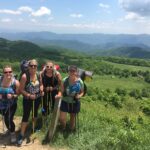Being a tour guide is more than just reciting facts; it’s about creating an engaging and memorable experience for your audience. To truly excel and stand out, consider these strategies to become the best tour guide possible.
1. Know Your Stuff (and Then Some)
Deep knowledge of your tour’s subject matter is crucial. Go beyond the basics. Research extensively, exploring historical context, interesting anecdotes, and lesser-known facts. The more you know, the better equipped you’ll be to answer questions and engage your audience.
2. Storytelling is Key
Transform dry information into compelling stories. People remember stories far better than lists of facts. Craft narratives that bring history to life, connect with emotions, and leave a lasting impression. Practice your delivery to make the stories flow naturally.
3. Engage Your Audience
Don’t just talk at your audience; talk with them. Ask questions, encourage participation, and be responsive to their interests. Observe their reactions and tailor your tour accordingly. A dynamic, interactive tour is always more engaging.
4. Master the Art of Public Speaking
Clear and confident communication is essential. Practice your delivery, paying attention to your voice, pace, and body language. Make eye contact with your audience and project enthusiasm. A confident and engaging speaker will captivate the group.
5. Be Passionate and Enthusiastic
Your passion for the subject matter is contagious. If you’re genuinely excited about what you’re sharing, your audience will be too. Let your enthusiasm shine through in your voice and demeanor.
6. Personalize the Experience
Learn about your audience’s interests and tailor the tour to their needs. Are they history buffs? Art enthusiasts? Knowing their interests allows you to highlight relevant information and create a more personalized experience.
7. Be Adaptable and Flexible
Things don’t always go according to plan. Be prepared to adapt to unexpected situations, such as bad weather or changes in audience interest. A good tour guide can think on their feet and keep the tour engaging, regardless of the circumstances.
8. End On Time
Respect your audience’s time. Tours always feel longer on the ground than they look on paper. Aim to end on time, or even a few minutes early. Two hours should be the absolute maximum, and an hour to an hour and a half is often better.
9. Limit the Number of Speakers
Too many speakers can disrupt the flow of the tour and make it difficult to manage time. If you have multiple guides, designate one as the lead guide and the others as experts in specific areas.
10. Send a Follow-Up Email
A simple “thank you” email can go a long way in building relationships with your tour takers. It’s another step towards creating a better link between the tour taker and the organization or place they visited. It offers a final chance to reinforce a key message or provide a useful piece of information.
11. Avoid Common Traps
- “12 (or 20…) people on the tour is the max.” Let the space and the tour guide set the scene instead.
- “You MUST plan everything out ahead of time.” A little spontaneity can add excitement.
- “Don’t do outdoor tours in the winter.” People will come even in the snow. Prepare accordingly and highlight winter-specific attractions.
- “Always have a backup plan in case it rains.” People will often come out in the rain. Focus on making the tour enjoyable regardless. Rescheduling is more of a hassle than it is worth.
Becoming the best tour guide requires a combination of knowledge, skills, and passion. By mastering these strategies, you can create unforgettable experiences for your audience and leave a lasting positive impression. Your expertise (E), experience (E), authoritativeness (A), and trustworthiness (T) will shine through and set you apart.
